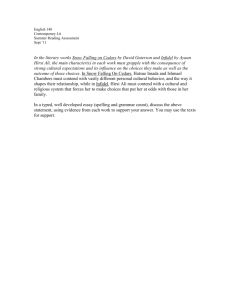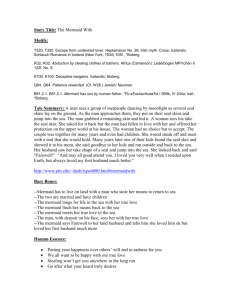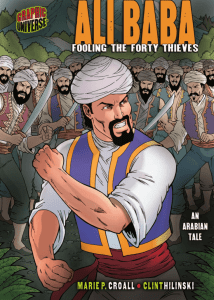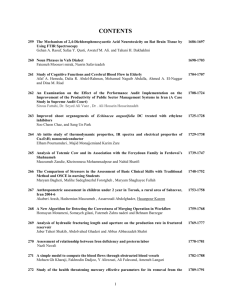Chapter
advertisement
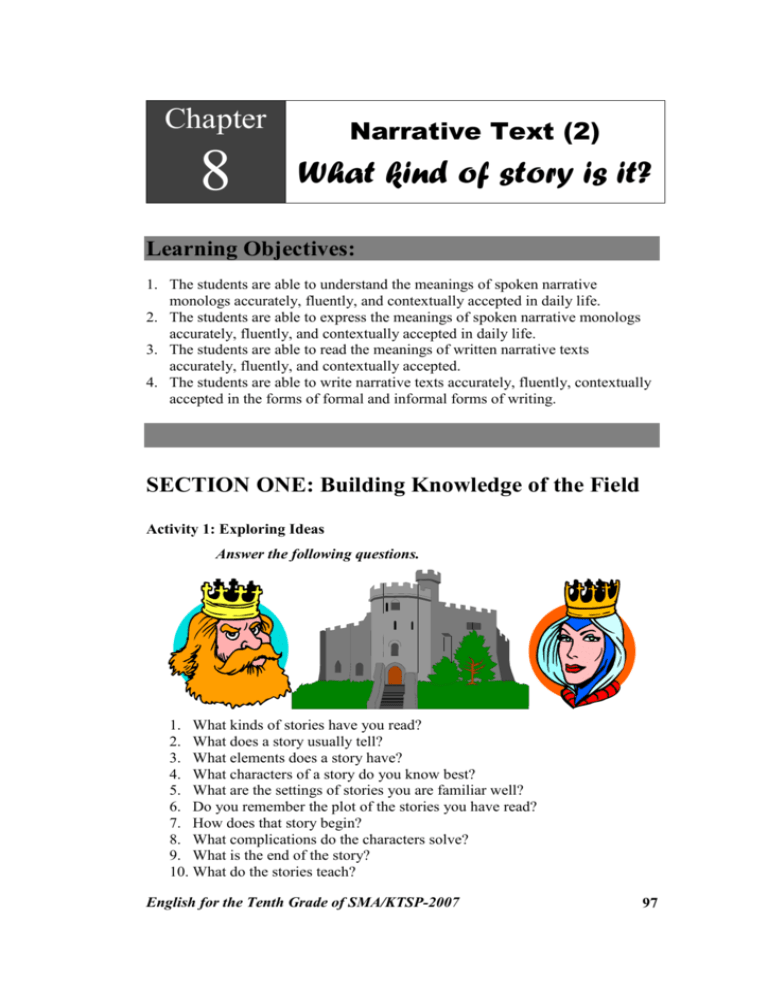
Chapter Narrative Text (2) 8 What kind of story is it? Learning Objectives: 1. The students are able to understand the meanings of spoken narrative monologs accurately, fluently, and contextually accepted in daily life. 2. The students are able to express the meanings of spoken narrative monologs accurately, fluently, and contextually accepted in daily life. 3. The students are able to read the meanings of written narrative texts accurately, fluently, and contextually accepted. 4. The students are able to write narrative texts accurately, fluently, contextually accepted in the forms of formal and informal forms of writing. SECTION ONE: Building Knowledge of the Field Activity 1: Exploring Ideas Answer the following questions. 1. What kinds of stories have you read? 2. What does a story usually tell? 3. What elements does a story have? 4. What characters of a story do you know best? 5. What are the settings of stories you are familiar well? 6. Do you remember the plot of the stories you have read? 7. How does that story begin? 8. What complications do the characters solve? 9. What is the end of the story? 10. What do the stories teach? English for the Tenth Grade of SMA/KTSP-2007 97 Activity 2: Identifying the elements of the story Fill in the table based on the following stories. Identify the following: 1. The characters (Who are they? 2. The Setting (When and where did the stories happen?) 3. The Plot (Beginning, Complication, Climax, Resolution, Ending) Malin Kundang Ali Baba Aladdin Bawang Merah and Bawang Putih Sangkuriang English for the Tenth Grade of SMA/KTSP-2007 Romeo and Juliet 98 Title Malin Kundang Main Character Malin Kundang Other Characters Malin Kundang’s mother Malin Kundang’s wife Trader Setting West Sumatra Village Ocean Aladdin Ali Baba Bawang Merah and Bawang Putih Sangkuriang Romeo and Juliet English for the Tenth Grade of SMA/KTSP-2007 99 Task 3: Study the following features of narratives. A. Schematic Structure of Narrative Orientation: sets the scene and introduces the participants (When? Who? Where?) Complication: a crisis arises (What was the problem?) Resolution: the crisis is resolved, for better or for worse (How was the problem resolved? How did the story end?) Re-orientation: (optional stage) B. Linguistic Features of Narrative Specific participants: Sangkuriang, Ali Baba, Aladdin, Romeo, etc. Action verbs(material processes): made, killed, ate, ran, climbed, hunted, wrote, etc. Saying verbs (verbal processes): said, told, exclaimed, protested, asked, shouted, etc. Mental verbs (mental processes): think, thought, believed, considered, hoped, feel, suffered, etc. Linking verbs (relational processes): is, am, are, was, were, had been, will be, can be, will have been, etc. Temporal connectives: when, first, until, then, finally etc. Temporal circumstances: once upon a time, many centuries ago, etc. Spatial circumstances: in the kingdom, in the palace, in the forest, etc. Simple past: (all past formed/verb-2 used in the narratives) English for the Tenth Grade of SMA/KTSP-2007 100 SECTION TWO: Modeling of the Text Activity 4: Studying the schematic structure of the narrative text Study the schematic structure of the following narrative text. (Source: VCD Ali Baba) Ali Baba and the Forty Thieves Orientation Major Complication Complication Resolution There once was a poor woodcutter, named Ali Baba. He lived in the small wooden house near the forest. One day he was gathering wood in the forest when a band of thieves approached. He hid and watched them enter a cave that opened when they said the words, “Alakazam, open!” After they departed, Ali Baba stood before the cave and gave the command “Alakazam, open!” He was surprised, the cave opened to reveal an enormous supply of gold and treasures. Ali Baba packed some of the gold on his donkeys and returned home. His brother Qasim was rich but hardhearted merchant, discovered Ali Baba's new wealth, he demanded an explanation. The next day Qasim visited the cave and greedily gathered as much treasure as he could, but forgot the formula for leaving the cave. The thieves opened the cave and found Qasim over there. The leader of the thieves killed him. Qasim’s wife was worried why her husband did not come home for a day. She asked Ali Baba to look for him. Ali Baba went to the cave and was surprised that his brother killed. He brought his brother’s body home and one knew it and reported that to the leader of the thieves. The following day the leader of the thieves planed to kill Ali Baba and he came to his house. He tried to kill him, fortunately his slave, Murganah, helped him. She swung a sword and killed the leader of the thieves. Murganah freed Ali Baba from the murder. Finally Ali Baba married Murganah and they lived happily ever after. English for the Tenth Grade of SMA/KTSP-2007 101 Activity 5: Studying the linguistic features of the narrative text Study the schematic structure of the following narrative text. Ali Baba and the Forty Thieves There once was a poor woodcutter, named Ali Baba. He lived in the small wooden house near the forest. One day he was gathering wood in the forest when a band of thieves approached. He hid and watched them enter a cave that opened when they said the words, “Alakazam, open!” After they departed, Ali Baba stood before the cave and gave the command “Alakazam, open!” He was surprised, the cave opened to reveal an enormous supply of gold and treasures. Ali Baba packed some of the gold on his donkeys and returned home. His brother Qasim was rich but hardhearted merchant, discovered Ali Baba's new wealth, he demanded an explanation. The next day Qasim visited the cave and greedily gathered as much treasure as he could, but forgot the formula for leaving the cave. The thieves opened the cave and found Qasim over there. The leader of the thieves killed him. Qasim’s wife was worried why her husband did not come home for a day. She asked Ali Baba to look for him. Ali Baba went to the cave and was surprised that his brother killed. He brought his brother’s body home and one knew it and reported that to the leader of the thieves. The following day the leader of the thieves planed to kill Ali Baba and he came to his house. He tried to kill him, fortunately his slave, Murganah, helped him. She swung a sword and killed the leader of the thieves. Murganah freed Ali Baba from the murder. Finally Ali Baba married Murganah and they lived happily ever after. Specific Participant Spatial Circumstance Temporal Circumstance Temporal Conjunction Action Verb Linking Verb Past Tense Verbal Verb Spatial Circumstance Specific Participant Verbal Verb Verbal Verb Specific Participant Temporal Connective (Source: Adapted from Microsoft® Encarta® Reference Library 2003. Contributed By Hasan M. El-Shamy) English for the Tenth Grade of SMA/KTSP-2007 102 Activity 6: Answering the questions Answer the following questions based on the text above. 1. What is the purpose of writing a narrative text? 2. How did the story begin? 3. Who are the characters? 4. Who is the main character? 5. Where did the story take place? 6. When did it happen? 7. What problem did Ali Baba have based on the story? 8. How did he solve the problem? 9. Who helped Ali Baba? 10. How were the thieves? 11. What is the end of the story? 12. What is the theme of the story? 13. What lesson does the story teach? 14. Can you find the daily problem which is the same as the story? 15. What lesson can you take from this story? Activity 7: Finding the past tense used in the story Write ten sentences of the past tense used in the story. 1. ………………………………………………………………………….. 2. ………………………………………………………………………….. 3. ………………………………………………………………………….. 4. ………………………………………………………………………….. 5. ………………………………………………………………………….. 6. ………………………………………………………………………….. 7. ………………………………………………………………………….. 8. ………………………………………………………………………….. 9. ………………………………………………………………………….. 10. ………………………………………………………………………….. English for the Tenth Grade of SMA/KTSP-2007 103 SECTION THREE: Joint Construction of the Text Activity 8: Analyzing the schematic structure of the narrative text Study the schematic structure of the following narrative text. 1. Which paragraph is Orientation of the story? 2. Which paragraph is Complication of the story? 3. Which paragraph is Resolution of the story? 1 2 3 4 5 6 Once upon a time there lived a little girl named Snow White, She lived with her Aunt and Uncle because her parents were died. One day she heard her Uncle and Aunt talking about leaving Snow White in the castle because they both wanted to go to America and they didn’t have enough money to take Snow White. Snow White did not want her Uncle and Aunt to do this so she decided it would be best if she ran away. The next morning she ran away from home when her Aunt and Uncle were having breakfast. She ran away into the woods. She was very tired and hungry. Then she saw this little cottage. She knocked but no one answered so she went inside and fell asleep. Meanwhile, the seven dwarfs were coming home from work. They went inside. There they found Snow White sleeping. Then Snow White woke up. She saw the dwarfs. The dwarfs said, “What is your name?” Snow White said, “My name is Snow White.” Doc said, “If you wish, you may live here with us”. Snow White said, “Oh could I? Thank you.” Then Snow White told the dwarfs the whole story and Snow White and the 7 dwarfs lived happily ever after. English for the Tenth Grade of SMA/KTSP-2007 104 Activity 9: Analyzing the linguistic features of the narrative text Study the schematic structure of the following narrative text. Specific participant, action verb, verbal verb, mental verbs, linking verb, temporal connectives, temporal circumstances, spatial circumstances, past tense. 1 Once upon a time there lived a little girl named Snow White, She lived with her Aunt and 2 Uncle because her parents were died. One day she heard her Uncle and Aunt talking 3 4 5 13 14 about leaving Snow White in the castle because they both wanted to go to America and they didn’t have enough money to take Snow White. 15 Snow White did not want her Uncle and Aunt to do this so she decided it would be best if she ran away. The next morning she ran away from home 16 17 when her Aunt and Uncle were having breakfast. She 6 ran away into the woods. 18 She was very tired and hungry. Then she saw 7 this little cottage. She knocked but no one answered 19 so she went inside and fell asleep. 8 Meanwhile, the seven dwarfs were coming home from work. They went inside. There they found 9 Snow White sleeping. Then Snow White woke up. She saw the dwarfs. The dwarfs said, “What is your 10 11 21 name?” Snow White said, “My name is Snow White.” Doc said, “If you wish, you may live here 22 with us”. Snow White said, “Oh could I? Thank you.” Then Snow White told the dwarfs the whole story and 12 20 23 Snow White and the 7 dwarfs lived happily ever after. Taken from Making Sense of Functional Grammar English for the Tenth Grade of SMA/KTSP-2007 105 Activity 10: Answering the question based on the text Reread the story above and answer the following questions. 1. What is the best title for the story above? ……………………………………………………… 2. Who is the main character? ……………………………………………………… 3. Who are other characters? ……………………………………………………… 4. Where did the story take place? ……………………………………………………… 5. What lesson can you take from this story? ……………………………………………………… Activity 11: Changing the verbs into the past form Read the following story and change the whole verbs into the past form. Rewrite the story in the provided space below. Aladdin is the lazy son of a poor Chinese tailor. After his father's death, he meets a magician who posses as his uncle and persuades Aladdin to retrieve a wonderful lamp from a hidden cave. When Aladdin fails to give the lamp to the magician before emerging from the cave, the magician becomes enraged and seals the cave, leaving Aladdin to die. In his misery Aladdin weeps and wrings his hands, releasing a genie from a ring the magician had given him. The genie frees Aladdin, who soon discovers that the lamp also produces powerful genies when rubbed. They grant Aladdin his every wish, and he eventually becomes immensely wealthy and marries the daughter of the sultan. Free of these enemies, Aladdin lives a long, happy life and succeeds the sultan to the throne. English for the Tenth Grade of SMA/KTSP-2007 106 Orientation : ……………………………………………………………………. ……………………………………………………………………. Complication : ……………………………………………………………………. ……………………………………………………………………. ……………………………………………………………………. Resolution : ……………………………………………………………………. ……………………………………………………………………. Activity 12: Answering the questions Answer the following questions based on the story above. Do this in your group. 1. What is the best title of the story above? ……………………………………………………………………………… 2. Who is the main character? ……………………………………………………………………………… 3. Who are other characters of the story? ……………………………………………………………………………… 4. Where did the story take place? ……………………………………………………………………………… 5. When do you think that story occurred? ……………………………………………………………………………… 6. What does the word “he” in the second sentence refer to? ……………………………………………………………………………… 7. How did the story begin? ……………………………………………………………………………… 8. What is the climax of the story? ……………………………………………………………………………… 9. How did the main character solve his problem? ……………………………………………………………………………… 10. What is the end of the story? ……………………………………………………………………………… English for the Tenth Grade of SMA/KTSP-2007 107 Activity 13: Choosing the correct answer based on the story Write T if it is true or F if it is false. 1. “Aladdin” is an original Indonesian story. ( T - F ) 2. Aladdin always rubbed his magic lamp to ask his wishes. ( T - F ) 3. Genies never came though Aladdin rubbed the lamp many times. ( T - F ) 4. Aladdin asked genies to kill the magician. ( T - F ) 5. Helping each other is the value of that story but asking genies wishes is forbidden. ( T - F ) SECTION FOUR: Independent Construction of the Text Activity 14: Analyzing the schematic structure of the narrative text Analyze the schematic structure: Orientation, Complication, Resolution and Reorientation, of the following stories. Once upon a time there was a young girl named Cinderella who lived with her stepmother and two stepsisters. Cinderella’s stepmother and stepsisters were conceited and bad tempered. They treated Cinderella very badly. Her stepmother made Cinderella do the hardest work in the house, such as scrubbing the floor and cleaning the pots and pans. She gave Cinderella an old ragged dress to wear. The two stepsisters, on the other hand, did no work about the house, and their mother gave them many handsome dresses to wear. One day the two stepsisters received an invitation to a ball that the king’s son was going to give at the palace. They were excited about this and spent so English for the Tenth Grade of SMA/KTSP-2007 108 much time choosing the dresses they would wear. At last the day of the ball came, and away went the sisters to it. Cinderella could not help crying after they had left. “Why are you crying, Cinderella? A voice asked. She looked up and saw her fairy godmother standing beside her. “Because I want so much to go to the ball,” said Cinderella. “Well,” said her godmother, “you’ve been such a cheerful, uncomplaining, hardworking girl that I am going to see that you do go to the ball”. Magically, the fairy godmother changed a pumpkin into a fine coach and mice into a coachman and two footmen. Her godmother tapped Cinderella’s ragged dress with her wand, and it became a beautiful ball gown. Then she gave her a pair of pretty glass slippers. “Now, Cinderella,“ she said, “you must leave before midnight.” Then, away she drove in her beautiful coach. Cinderella was having a wonderfully good time. She danced again and again with the king’s son. Suddenly, the clock began to strike twelve. She ran towards the door as quickly as she could. In her hurry, one of her glass slippers came off and was left behind. A few days later the king’s son proclaimed he would marry the girl whose foot fitted the glass slipper. The king’s page came to Cinderella’s house. Her stepsisters tried on the slipper but it was too small for them no matter how hard they squeezed their toes into it. The king’s page let Cinderella try on the slipper. She stuck out her foot, and the page slipped the slipper on. It fitted perfectly. Finally, she was driven to the palace. The king’s son was overjoyed to see her again. They were married and lived happily ever after. Activity 15: Analyzing the linguistic features of the narrative text Read the text above and write the linguistic features in the table. The simple past Specific participants Action verbs Saying verbs Linking verbs Mental verbs Time connectives Temporal circumstances Spatial circumstances English for the Tenth Grade of SMA/KTSP-2007 109 Activity 16: Rewriting the story Rewrite the story “Ali Baba” using your own words. Use the plan of narrative text provided below. A Narrative Text Plan Title: (Give an interesting title that attracts your reader’s attention) Orientation: sets the scene and introduces the participants (When? Who? Where?) Complication: a crisis arises (What was the problem?) Resolution: the crisis is resolved, for better or for worse (How was the problem resolved? How did the story end?) Re-orientation: (optional stage) Orientation : ……………………………………………………………………. ……………………………………………………………………. Complication : ……………………………………………………………………. ……………………………………………………………………. ……………………………………………………………………. Resolution : ……………………………………………………………………. ……………………………………………………………………. English for the Tenth Grade of SMA/KTSP-2007 110
